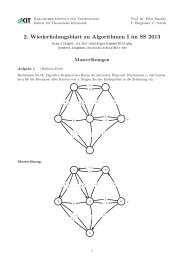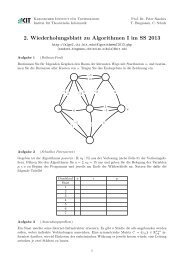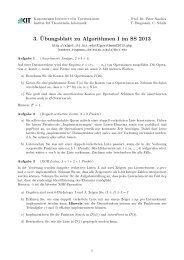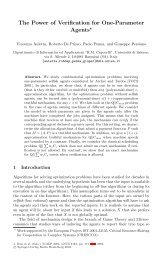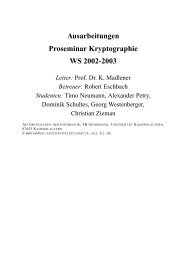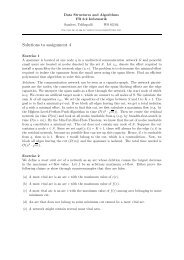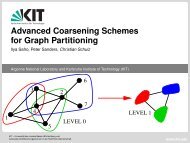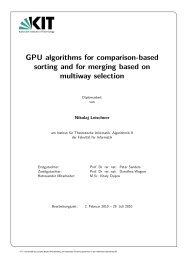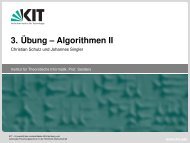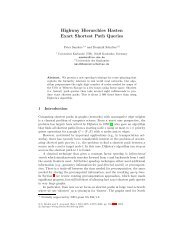Stxxl : Standard Template Library for XXL Data Sets - Max-Planck ...
Stxxl : Standard Template Library for XXL Data Sets - Max-Planck ...
Stxxl : Standard Template Library for XXL Data Sets - Max-Planck ...
Create successful ePaper yourself
Turn your PDF publications into a flip-book with our unique Google optimized e-Paper software.
queue operations in the MIS computation is almost compute bound. Comparing the running<br />
times of the total input graph generation we conclude that <strong>Stxxl</strong>-STL implementation is about<br />
20 % faster than TPIE and 53 % faster than LEDA-SM. This could be due to better (explicit)<br />
overlapping between I/O and computation. Another possible reason could be that TPIE uses<br />
a more expensive way of reporting run-time errors, such as I/O errors 7 . The running time of<br />
the filling stage of <strong>Stxxl</strong>-STL implementation is much higher than of TPIE and LEDA-SM.<br />
This is due to the fact that those libraries rely on operating system cache. The filled blocks do<br />
not go immediately to the disk(s) but remain in the main memory until other data needs to be<br />
cached by the system. The indication of this is the very high bandwidth of 52 MB/s <strong>for</strong> TPIE<br />
implementation, which is even higher than the maximum physical disk bandwidth (48 MB/s) at<br />
its outermost zone. However, the cached blocks need to be flushed in the sorting stage and then<br />
the TPIE implementation pays the remaining due. The unsatisfactory bandwidth of 24 MB/s<br />
of the <strong>Stxxl</strong>-STL filling phase could be improved by replacing the call std::generate by the<br />
native stxxl::generate call that efficiently overlaps I/O and computation. With a single disk<br />
it fills the vector in 60 seconds with a bandwidth of 33 MB/s. <strong>Stxxl</strong> STL-user sorter sustains<br />
an I/O bandwidth of about 45 MB/s, which is 95 % of the disk’s peak bandwidth. The high<br />
CPU load in the priority queue and not very perfect overlapping between I/O and computation<br />
explain the low bandwidth of the MIS computation stage in all three implementations. We also<br />
run the graph generation test on 16 GByte inputs. All implementations scale almost linearly<br />
with the input size: the TPIE implementation finishes in 1h 3min, <strong>Stxxl</strong>-STL in 49min, and<br />
<strong>Stxxl</strong>-Pipelined in 28min.<br />
The MIS computation of <strong>Stxxl</strong>, which is dominated by PQ operations, is 3.35 times faster<br />
than LEDA-SM. The main reason <strong>for</strong> this big speedup is likely to be the more efficient priority<br />
queue algorithm from [31].<br />
Table 2: Running time (in seconds)/I/O bandwidth (in MB/s) of the MIS benchmark running<br />
on multiple disk.<br />
<strong>Stxxl</strong>-STL <strong>Stxxl</strong>-Pipelined<br />
Disks 2 4 2 4<br />
Input Filling 72/28 64/31<br />
98/20 98/20<br />
graph Sorting 104/77 80/100<br />
generation Dup. removal<br />
MIS computation<br />
58/69<br />
127/25<br />
34/118<br />
114/28<br />
112/30 110/31<br />
Total 360/50 291/61 210/26 208/27<br />
Table 2 shows the parallel disk per<strong>for</strong>mance of the <strong>Stxxl</strong> implementations. The <strong>Stxxl</strong>-STL<br />
implementation achieves speedup of about 1.5 using two disks and 1.8 using four disks. The reason<br />
<strong>for</strong> this low speedup is that many parts of the code become compute bound: priority queue<br />
operations in the MIS computation stage, run <strong>for</strong>mation in the sorting stage, and generating random<br />
edges in the filling stage. The <strong>Stxxl</strong>-Pipelined implementation was almost compute bound<br />
in the single disk case, and as expected, with two disks the first phase shows no speedup. However<br />
the second phase has a small improvement in speed due to faster I/O. Close to zero I/O wait time<br />
indicates that the <strong>Stxxl</strong>-Pipelined implementation is fully compute bound when running with<br />
two or four disks. We had run the <strong>Stxxl</strong>-Pipelined implementation on very large graphs that<br />
7 TPIE uses function return types <strong>for</strong> error codes and diagnostics, which can become quite expensive at the level<br />
of the single-item interfaces (e.g. read item and write item) that is predominantly used in TPIEs algorithms.<br />
Instead, <strong>Stxxl</strong> checks (I/O) errors on the per-block basis. We will use C++ exceptions to propagate errors to the<br />
user layer without any disadvantage <strong>for</strong> the library users. First experiments indicate that this will have negligible<br />
impact on runtime.<br />
16



